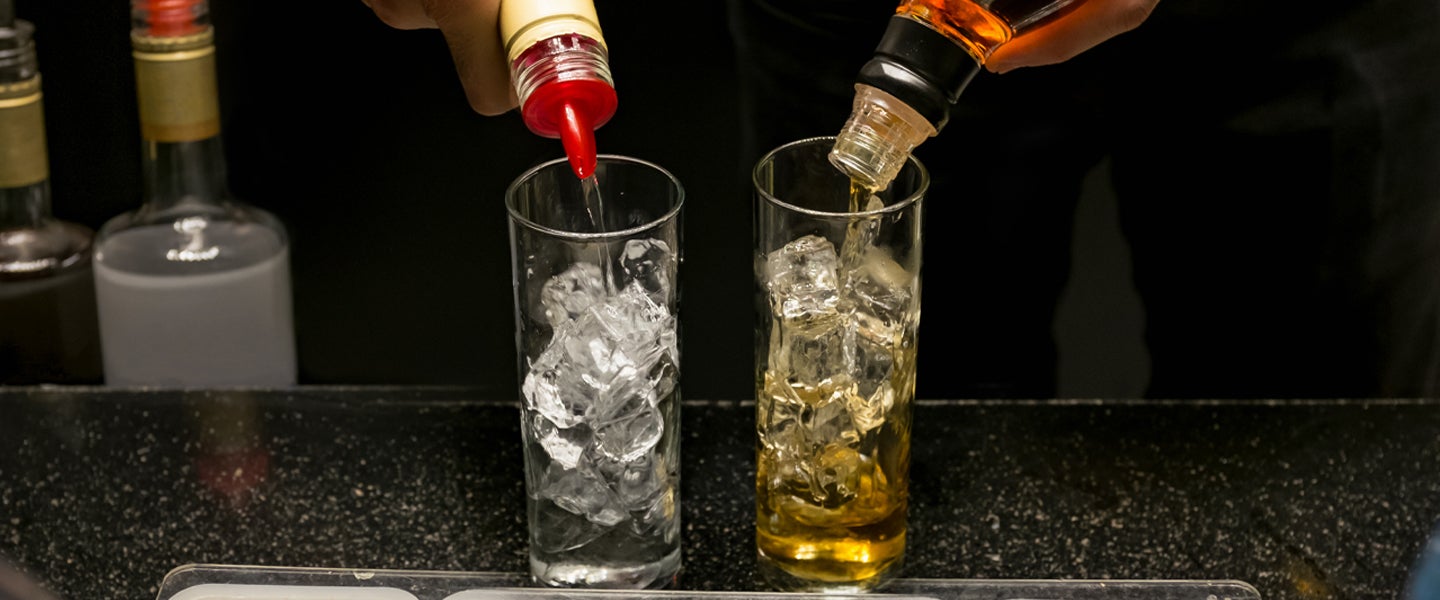Nobody likes being made to pay for stuff, and so it goes with two-drink minimums. They’re a staple of comedy clubs, but you’ll also frequently find them at jazz clubs, strip clubs and any other kind of cabaret-style entertainment. But why would an establishment come up with this rule (besides, one initially assumes, to gouge you)? What’s the money go to? What happens if you don’t drink two drinks? How’s it even enforced? Can you get something else instead? What’s the deal with them? Alongside Mike Vinn, the manager (and bartender, and comedian, and marketing guy) at the La Jolla location of the legendary Comedy Store, we’re warming up some answers.
So, why would a comedy club (or anywhere else) make customers buy two drinks?
It does come off like an obligation, doesn’t it? Buy two drinks — we’re charging you for them anyway! Allow, then, Vinn to break down the economics of it. “It’s a simple concept,” he says. “We have all the brick-and-mortar to pay for: the lights, the wait staff, all that other stuff that goes into a business. So when you go to a comedy club, basically, the ticket price goes toward the comics and the two-drink minimum goes toward paying the bills. Just realize that when you pay for tickets, that’s paying for the entertainment; you paying for your drinks is allowing us to have a place for you to come watch comedy.”
The talent gets all the ticket revenue?
Not quite, but it does happen often enough — it all depends on the deal between the comedian and the booker. “Some comics get 100 percent, some get 90 percent, some get a flat fee,” Vinn says. “Sometimes we give away free or discounted tickets just because we need people in the seats to make sure we can pay for everything.” Which is to say, those free and discounted tickets come with a two-drink minimum as well.
Why not just increase the face value of the ticket?
Because this system actually benefits the customer! “Do you want to spend $30 or $40 on a ticket to a show?” says Vinn, who, it should be noted, has a degree in marketing. “I mean, if you’re going out, you’re probably gonna have a couple of refreshments anyway. So we keep the ticket prices as low as possible, then you get to pick how much you spend for the rest of the night.”
The whole thing is based on the assumption that you’re going to be quenching your thirst anyway, whether or not it’s got alcohol, so they include the drinks in the cost, based on a broad acceptance of societal norms that you’re going to drink (or, in establishments that serve food, eat) something anyway while you’re being entertained. It works out far better for the customer than having the club factor their costs into the ticket, then having to pay for refreshments that you’re probably going to buy already.
Do non-alcoholic drinks really count toward the minimum?
Yep! Some people opt for bottles of water, sparkling water, non-alcoholic beer, soft drinks or juices.
And food counts?
Yessir! That’s where you’ll see it described as a two-item minimum. Depends on the place, though: The Comedy Store, for example, doesn’t serve food. “It’s just because [founder] Mitzi Shore didn’t want people choking while they were laughing,” Vinn says. “You’ve got to realize that back in the day when [the Comedy Store was founded], Robin Williams and Richard Pryor were tearing it up. David Letterman was just an opening act. So with that kind of talent pool coming through every weekend, it was a safety precaution — she didn’t want people dying from a jalapeño popper.”
How common is the two-drink minimum?
It’s super old — it’s been around at least as long as “Take my wife!” Nobody from the various comedy clubs I contacted seems to know when or where it started, though — it could have been a standard taken from jazz clubs long ago, which to this day still have drink minimums or table minimums. (Here’s an aptly named jazz album.) You’ll see it in strip clubs sometimes too, but it’s definitely a prominent fixture at comedy clubs. Comedy Central named one of its mid-1990s shows exactly this.
Go on then, have you got any good jokes about two-drink minimums?
Pauly Shore, son of Comedy Store founders Mitzi and Sammy Shore, likes to say, “My dad started the Comedy Store in Hollywood, my mom started the one down here [in La Jolla]. I grew up at the Comedy Store, so basically my whole life has been a two-drink minimum.”
Huh.
Yeah. Let’s move on, shall we?
Please. How is it enforced?
Establishments that enforce drink or item minimums usually have table service, so your waiter or waitress keeps track of it. If you don’t order two things, you’ll be charged for them anyway, end of story. Often, there are signs and notices everywhere: On the website when you buy tickets; on the phone when you call; and out of the doorman’s mouth when they card you. And if you put up a fuss about it, do you really want to get roasted by the comedian on stage? Or if this is at a strip club, do you really want to be beaten to a bloody pulp in a back alley by the bouncer?
Fair point. But why two drinks?
Vinn says you don’t want the audience forced into getting completely hammered for comedy, as it can ruin the show. “People lose control of their inhibitions and will go crazy,” he says. Forcing people to have more is in no one’s best interest — most people can generally handle two drinks, is the line of reasoning, so, two it is.
Cheers (twice).

